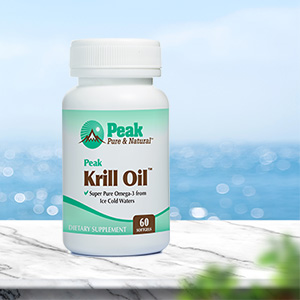Get Easy Health Digest™ in your inbox and don’t miss a thing when you subscribe today. Plus, get the free bonus report, Mother Nature’s Tips, Tricks and Remedies for Cholesterol, Blood Pressure & Blood Sugar as my way of saying welcome to the community!
The other omega fatty acid that fights cancer, heart disease and diabetes

You’ve probably heard that omega-3 fatty acids fight inflammation and disease, while omega-6 fatty acids fuel them. But recent research shows this isn’t entirely true. Omega-6 fatty acids from healthy sources aren’t the inflammation-causing boogeymen they’ve been made out to be…
A 2017 study found that omega-6 fatty acids don’t cause chronic low-grade inflammation that raises the risk of disease and that the theory connecting them to inflammation and disease is oversimplified.
You see, omega-6 fatty acids got a bad reputation in the health world because the body turns linoleic acid (an omega-6 fatty acid found in vegetable oils) into arachidonic acid (also an omega-6 fatty acid). Arachidonic acid gets converted into a variety of pro-inflammatory compounds, hence the reason people think omega 6 fatty acids fuel inflammation.
But here’s the thing… arachidonic acid also gets converted into inflammation-fighting compounds. So, it may fuel some inflammation, but it also fights some.
It’s also important to mention that when you consume an omega-6 fatty acid like linoleic acid, very little of it gets converted into that supposedly inflammation-causing arachidonic acid. Both of those factors may be why — in most research — eating more omega-6 fatty acids doesn’t increase inflammation levels… and in some cases lowers it.
There’s even a lot of research that shows omega-6 fatty acids have some serious health benefits, like reducing the risk of heart disease and diabetes. And now, a new study shows these previously vilified fats may even act against cancer.
DGLA: The omega-6 fatty acid that could kill cancer cells
Researchers from Washington State University have confirmed that the omega-6 fatty acid dihomogamma-linolenic acid (DGLA) kills cancer cells.
These researchers started by testing the effect of DGLA on a roundworm known as Caenorhabditis elegans (C. elegans), because results found in this roundworm’s cells are often transferrable to human cells. They found that DGLA triggered a type of cell death in these roundworms that’s similar to something called ferroptosis in human cells.
Ferroptosis is cell death that’s triggered when cells don’t get enough iron. Cancer cells need a lot of iron to grow, so any therapy that can trigger ferroptosis has potential in the treatment of cancer. Since their results in C. elegans were promising, these researchers decided to test DGLA on human cancer cells.
And they found that DGLA successfully triggered ferroptosis in human cancer cells too.

Peak Krill Oil™
The deep sea discovery that supports heart, brain and joint health. One of the healthiest sources of essential fatty acids from the pure waters of Antarctica!
This isn’t the first time science has indicated that DGLA has health benefits. A study published in 2019 found that this omega-6 fatty acid can control the inflammation that contributes to atherosclerosis. This is pretty important since atherosclerosis is one of the leading causes of heart disease.
And although it didn’t home in on DGLA specifically, there was a 2016 study that found that high concentrations of omega-6 polyunsaturated fatty acid in the blood reduced the risk of type 2 diabetes.
How to make sure your omega-6 intake is just right
Since omega-6 fatty acids are in popular vegetable oils like safflower oil, sunflower oil, corn oil, soybean oil, many of us already get a lot of them in our diet. That means we don’t necessarily need to focus on getting more of them (unless you suspect you’re not getting enough because you don’t eat these oils).
Instead, it’s all about balance. Your ratio of omega-6 and omega-3 fatty acids should be 1:1. That means you should eat them both in equal amounts for optimum health. So, even though we’re talking about omega-6 fatty acids specifically here, you may want to consider whether you’re getting enough omega-3s to keep that ratio right… and increase your intake accordingly.
In fact, the experts at Harvard recommend: Eat more omega-3s, not fewer omega-6s.
But you’ll want to focus on getting your omega-6s from the healthiest sources possible. Choose organic, non-GMO vegetable oils and look to whole-food sources of omega-6, like sunflower seeds, walnuts and pumpkin seeds as well.
You may also want to consider supplementing with evening primrose oil or borage oil. Both of these healthy oils contain g-linolenic acid (GLA) which is converted in the body to dihomo-g-linolenic acid (DGLA) in the body.
Editor’s note: Discover how to live a cancer prevention lifestyle — using foods, vitamins, minerals and herbs — as well as little-known therapies allowed in other countries but denied to you by American mainstream medicine. Click here to discover Surviving Cancer! A Comprehensive Guide to Understanding the Causes, Treatments and Big Business Behind Medicine’s Most Frightening Diagnosis!
Sources:
- Omega-6 fatty acids do not promote low-grade inflammation — ScienceDaily.
- No need to avoid healthy omega-6 fats — Harvard Health Publishing.
- Targeting Ferroptosis to Iron Out Cancer — Cancer Cell.
- Omega-6 fatty acids – What, why, where and how? — Peter Lapinskas, MA PhD.
- Study finds fatty acid that kills cancer cells — MedicalXpress.
- Dietary Lipids Induce Ferroptosis in Caenorhabditis elegans and Human Cancer Cells — Developmental Cell.
- An omega-6 fatty acid could help in fight against heart disease — MedicalXpress.
- High serum omega-6 polyunsaturated fatty acid concentrations linked to lower risk of type 2 diabetes — MedicalXpress.












